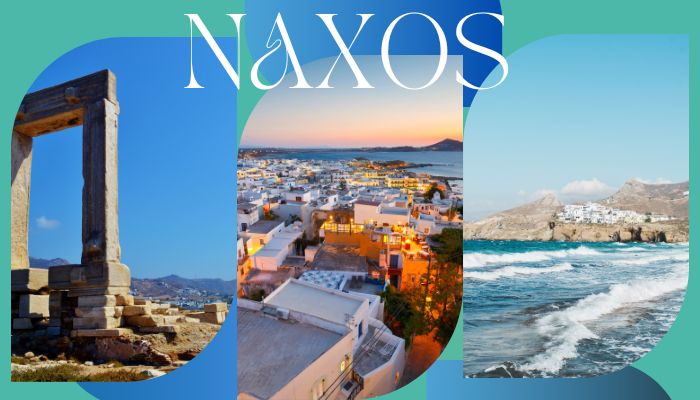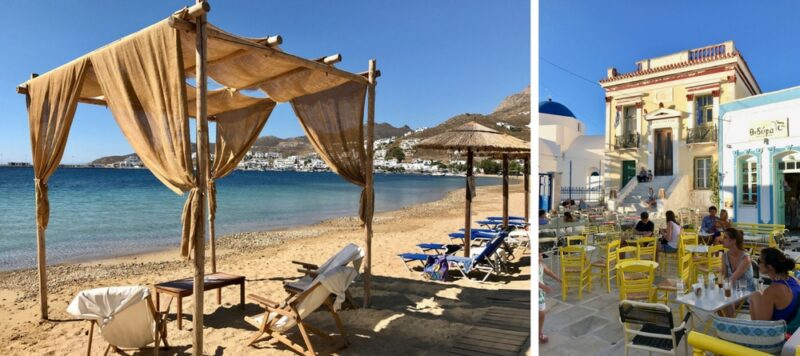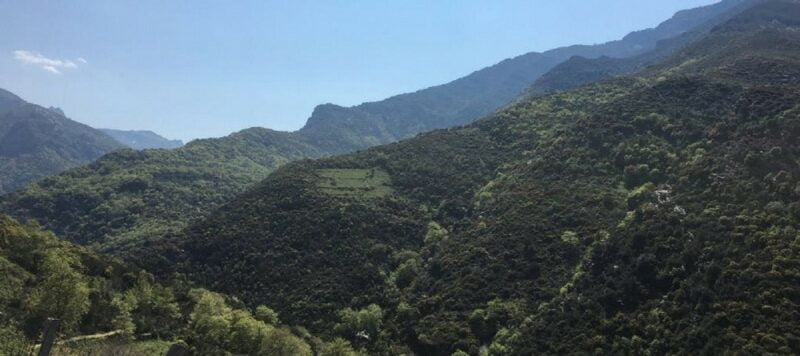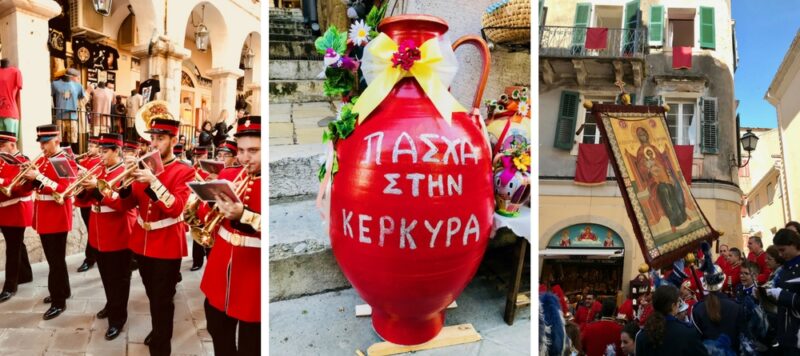The Greek island of Lemnos, also known as Limnos, is full of secrets waiting to be discovered. Located in the northeast of the Aegean Sea, Limnos or Lemnos is surrounded by Samothrace and Thasos to the north; Mount Athos and Halkidiki to the west; the Sporades and Agios Efstratios to the south; and Lesbos and Turkey to the east. Its 500 km² are home to a unique diversity of landscapes: fine sandy beaches, volcanic hills, authentic villages, archaeological sites, renowned vineyards and even… an authentic desert! Home to Hephaestus and Philoctetes, Lemnos is a fertile land where nature and mythology merge. So, where do you start to tame this little-known gem of Greece? Here are 16 must-see places on Limnos (Lemnos)!
- 1. Getting your bearings: Limnos map and essentials
- 2. Limnos between myth and reality
- 3. Visit Myrina, the capital of the island of Limnos
- 4. Admire the stunning chapel of Panagia Kakaviotissa
- 5. Discover the Cabires sanctuary and Philoctetes cave
- 6. Contemplate the remains of the ancient city of Hephaestia
- 7. Discover the unusual landscapes of Limnos
- 8. Try your hand at water sports on the beaches of Lemnos
- 9. Stroll through the pretty village of Kontias
- 10. Birdwatching around the three marine lakes
- 11. Discover the archaeological site of Poliochni
- 12. Lemnos wine
- 13. Taste the culinary specialties of Lemnos
- 14. How do I get to the island of Limnos?
- 15. And getting around Lemnos?
- 16. Where to stay in Lemnos?
1. Getting your bearings: Limnos map and essentials
Island map and highlights
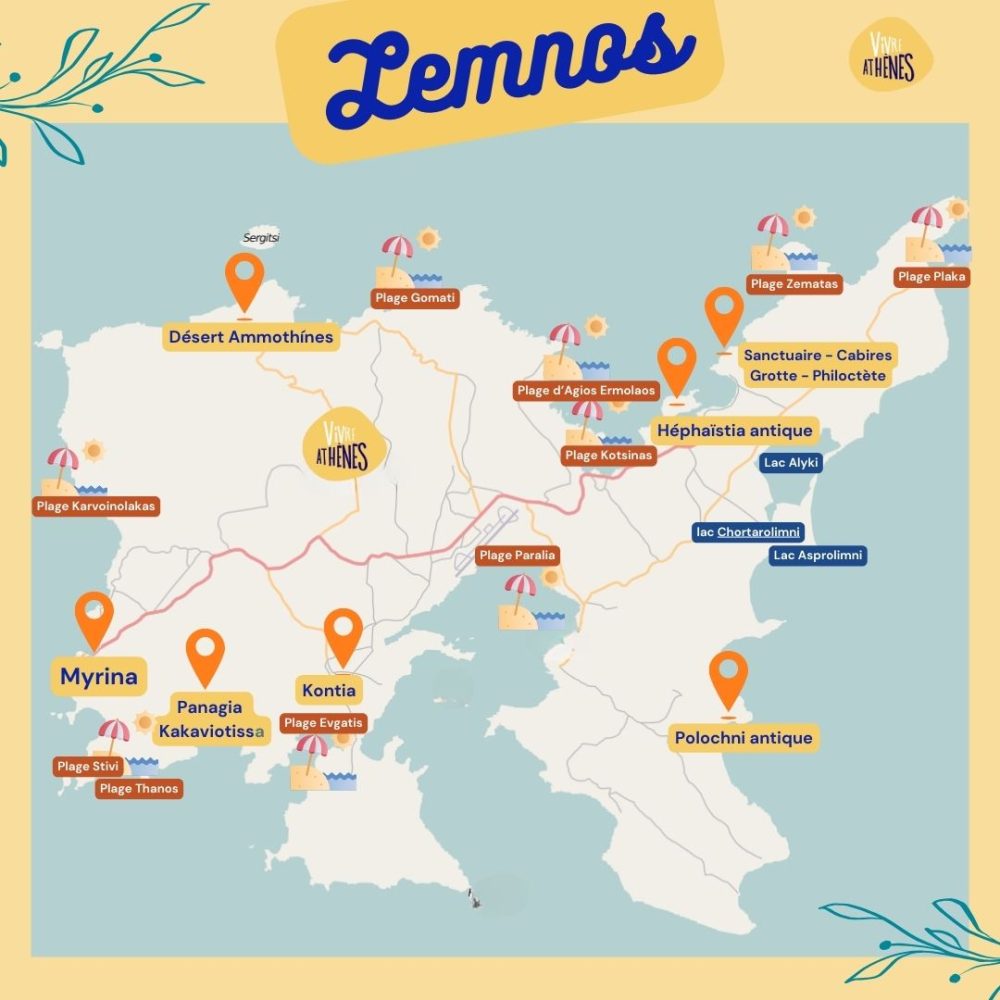
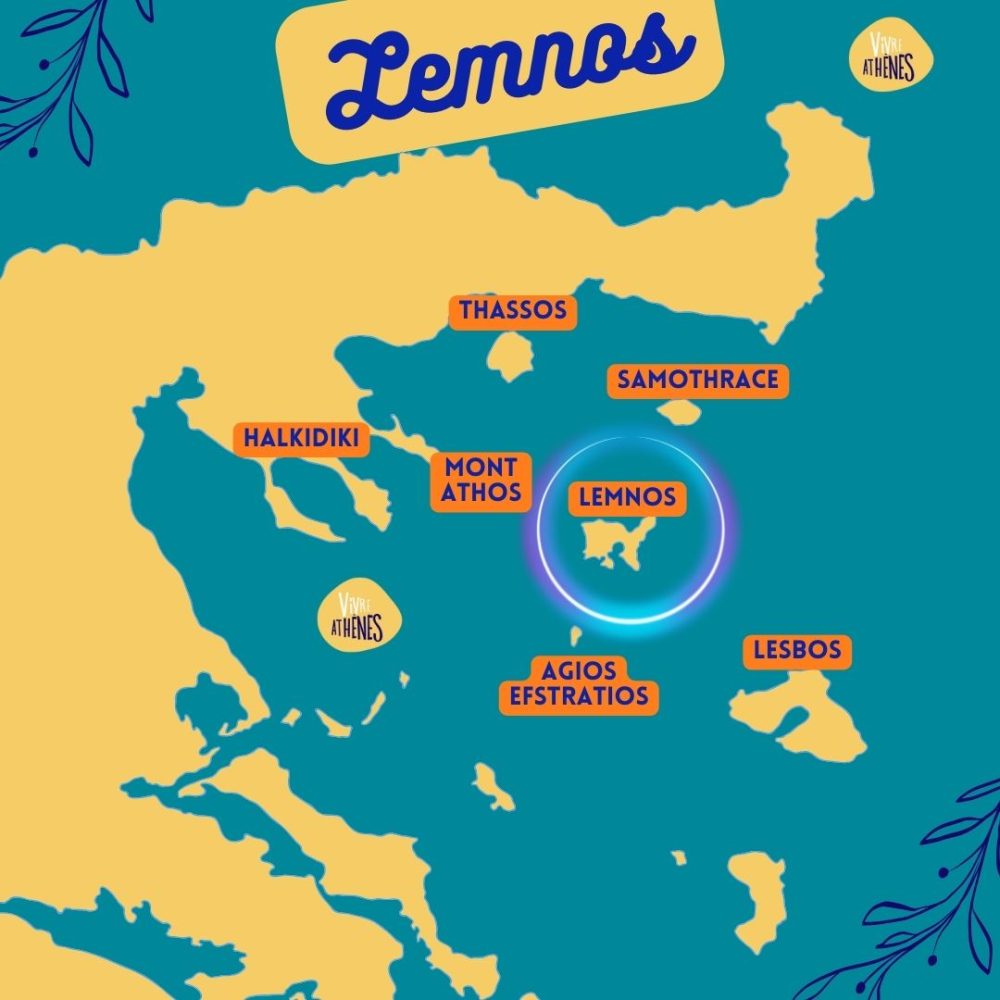
The Limnos story: key milestones
Ancient times :
By 512BC, Lemnos was under Athenian control. Like many Greek cities, it has a parliament and a senate.
Roman and Byzantine :
During the Byzantine period, Lemnos was the “granary of Constantinople” (cotton, wheat, wine or honey). It also plays a strategic role in controlling shipping routes.
Post-Byzantine and Ottoman period:
Like many Aegean islands during this period, Lemnos was often disputed between the Venetians, Genoese and Saracens. But the Ottomans ruled the island until 1913...
2. Limnos between myth and reality
Lemnos (or Limnos) is associated with several myths from Greek mythology. And that’s what we love about traveling to Greece: it’s traveling through these myths! There isn’t a place that isn’t linked to Greek mythology. So, here are some of the myths linked to Lemnos:
Jason and the Argonauts
The myth of Jason and the Argonauts is linked to Lemnos, as they stopped off there on their journey to find the Golden Fleece. The Argonauts were welcomed by the Lemniennes and helped restore order on the island, after discovering that the women had killed all the men!

Philoctetes
Philoctetes, a Greek hero, is associated with Lemnos in mythology. He was abandoned on the island because he had been wounded during the Trojan War. He lived on the island for many years and owned the bow of Heracles, which proved to be a crucial element in the Trojan War.
Hephaestus
The Greek god Hephaestus (or Vulcan in Roman mythology) is often associated with Lemnos. According to mythology, he was thrown from Olympus by his mother Hera, and landed on Lemnos where he continued his work as a blacksmith. He is also said to have forged the weapons used by the Argonauts during their stopover on the island.
3. Visit Myrina, the capital of the island of Limnos
Myrina is the largest and most dynamic town on Limnos.
A number of remarkable sites await you in Myrina:
- The Kastro of Myrina overlooks the town. Erected in the 12ᵉ century during the Byzantine era, the fortress was later restored by the Venetians. Its promontory offersone of the finest panoramic views of the island of Lemnos, and is also home to many wild deer. A word of advice: go for the sunset, it’s even more beautiful!
- The archaeological museum. Housed in a handsome neoclassical building, it contains numerous treasures from the island’s various archaeological sites. It is currently being renovated. More information on Odysseus Culture.
- The Episcopal church. These are the Metropolis of Limnos and Agios Leftratos, a small neighboring island. The museum of ecclesiastical heritage is also worth a visit.
From the town center, you can easily reach the beautiful beaches of Néa Maditos and Romeikos Gialos. In the evening, enjoy the lively alleys of Myrina, the cafés and bars, and treat yourself to a fine restaurant serving local specialties on the harbor!

4. Admire the stunning chapel of Panagia Kakaviotissa
The picturesque village of Thanos lies 4 km south of Myrina. Nestling among the hills, it is home to just a few hundred inhabitants. Climb up Mount Kakavos along a steep path for around 20 minutes to discover the marvellous chapel of Panagia Kakaviotissa.
The chapel is perfectly preserved and has 2 astonishing features:
- It is housed inside a cave, which keeps it sheltered from the elements.
- As a result, it’s a church without a roof. This special feature is said to be unique in the world!
Built in the 14ᵉ century, the chapel served as a refuge for the monks of Agios Efstratios fleeing Turkish invasions. Don’t miss out on this amazing treasure of local heritage!
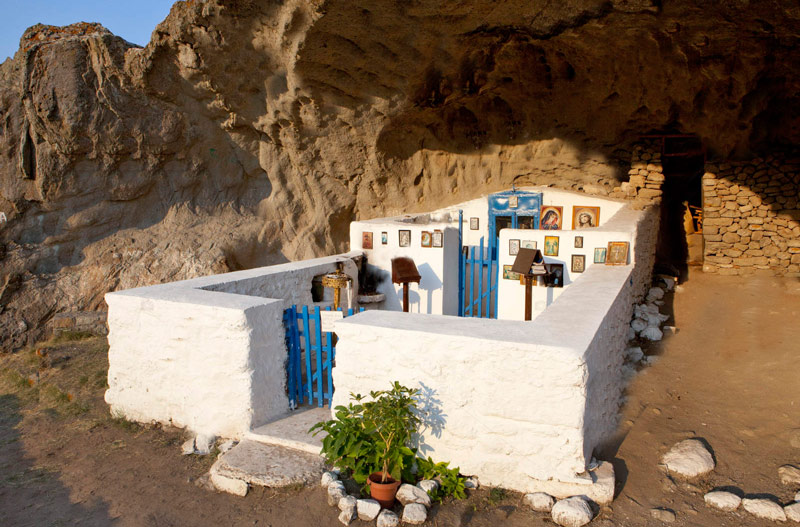
5. Discover the Cabires sanctuary and Philoctetes cave
On the northeast side of Limnos island, the archaeological site of the sanctuary of the Cabires (or temple of Kavirio) occupies the top of a cliff. This Hellenistic sanctuary was dedicated to the worship of the Cabir gods. You can still see 11 partial columns scattered around an impressive rocky setting. Admission to the site is charged (€3), and is open from 8:30 a.m. to 3:30 p.m. (closed on Tuesdays).
From the sanctuary, a signposted path leads down the cliff tothe legendary grotto of Philoctetes. This is where the mythical hero of the Trojan War is said to have taken refuge, while recovering from a snake bite. This is a sea cave, so the interior is only accessible by boat.
6. Contemplate the remains of the ancient city of Hephaestia
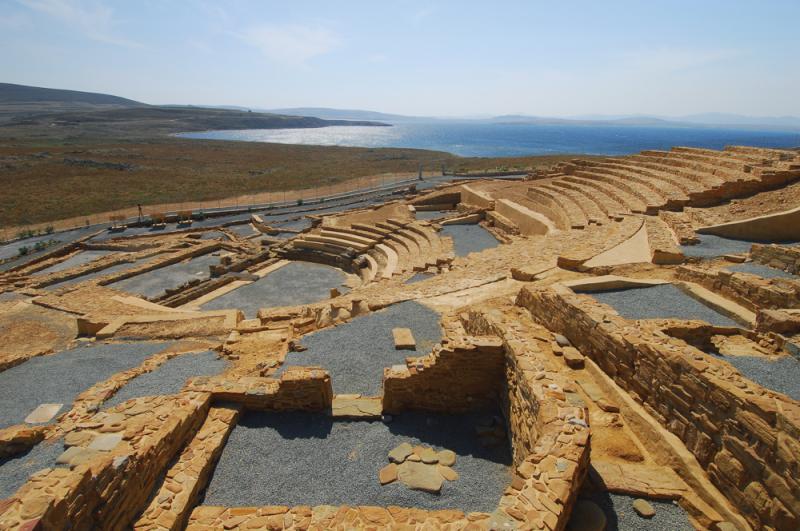
In the same region, don’t miss the archaeological site of Hephaestia, once the island’s capital. The ancient city owes its name to Hephaestus, the god of fire, forging, metallurgy and volcanoes. According to Greek mythology, the inhabitants of Lemnos took in Hephaestus when his father, Zeus, threw him off Mount Olympus.
The ancient theater of Hephaestia or Ifestia dates back to the 5ᵉ century B.C. It was restored between 2000 and 2004 and now hosts open-air events. Maybe you’ll be lucky enough to catch a theatrical performance there in summer!
Practical info: Access to the site is via a dirt track for the last few kilometers. The archaeological site is open from 8.30 a.m. to 3.30 p.m., every day except Tuesday. You will also be asked to pay an entrance fee of €3 (free for children). Further information on the Odysseus Culture website.
7. Discover the unusual landscapes of Limnos
Climb the dunes of the Ammothines desert
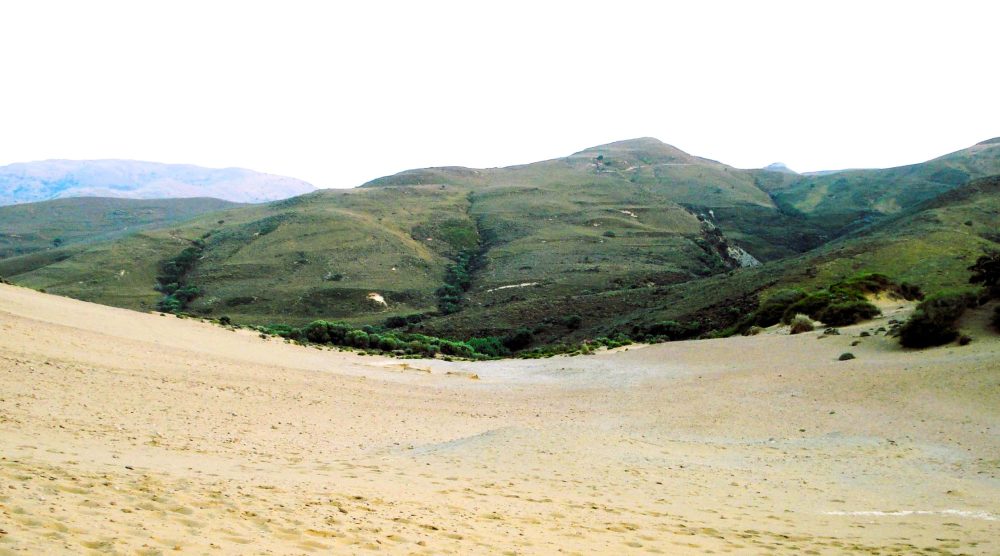
Did you know that the north of the island of Limnos is home to one of the few deserts in Europe? This is Ammothinès, a vast expanse of dunes in the Bay of Gomati. A unique experience in Greece!
To reach it, take a small dirt road from the village of Katalakkos. You’ll discover one of Greece’s most astonishing landscapes, the combination of the sea with a large dune of golden sand, sculpted by the wind and covered with unique vegetation. Allow half an hour on site. Point on map.
Then take a refreshing detour to the large, beautiful Gomati beach for a swim. Take a look at the panorama next to the old abandoned tank. And don’t forget to enjoy a delicious meal with a glass of local wine on the sea-view terrace of the Flomari tavern!
Discover Faraklo Geological Park
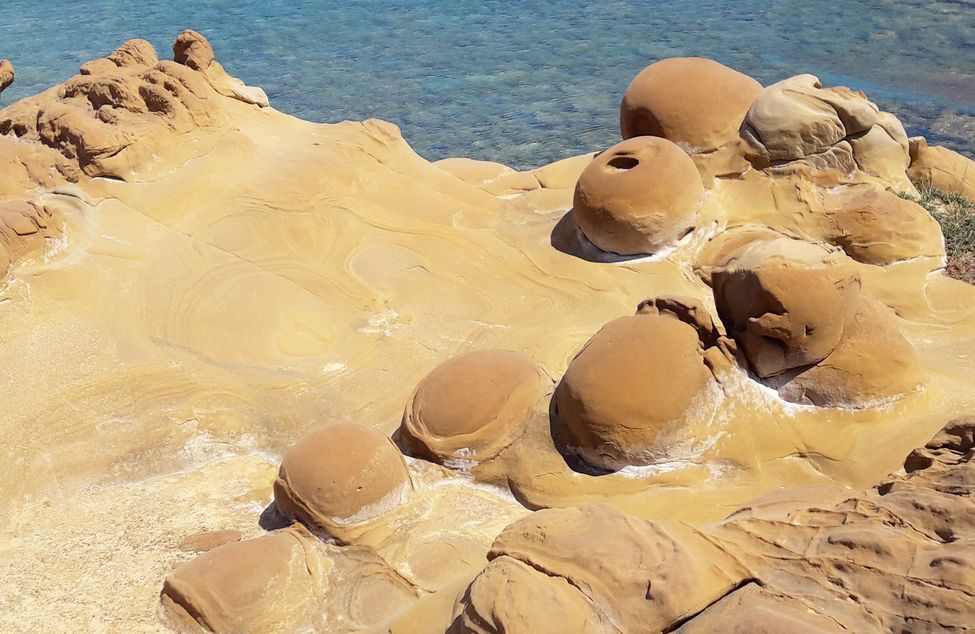
Welcome to a unique lunar landscape! In the north of the island, past the village of Propouli, the Faraklo geological park is made up of strange yellow spherical rocks, volcanic rocks formed when lava meets the sea.
The road to get there is a dirt track, quite tricky over the last few kilometers, but passable at a slow pace. You’ll be fully rewarded by this magnificent and unusual landscape!
8. Try your hand at water sports on the beaches of Lemnos
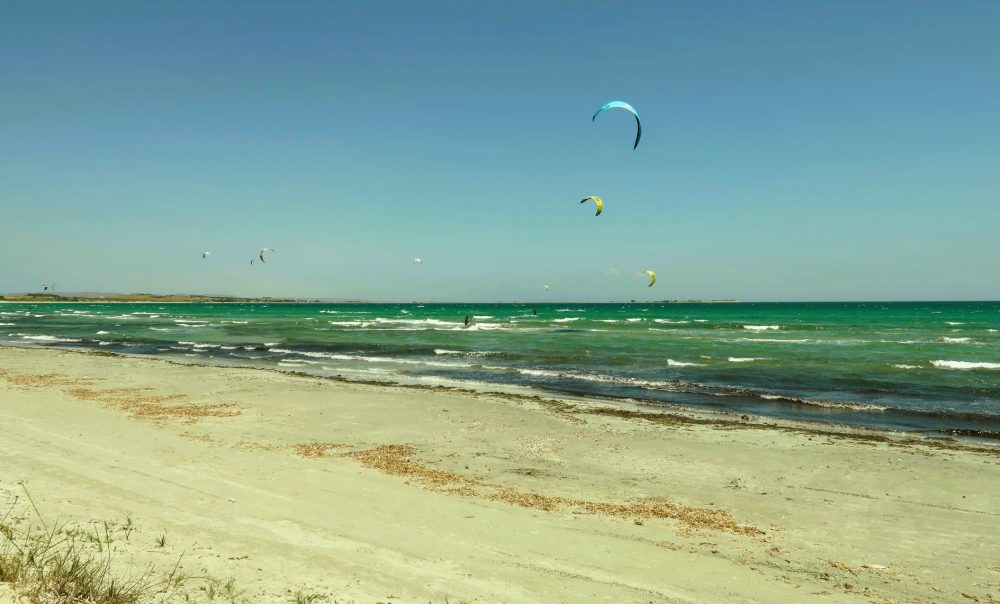
The island of Limnos is renowned for its surfing, windsurfing and kitesurfing spots. If you like playing with the waves, Keros beach is the place for you!
Located in Kalliopi Bay, this beach is home to several popular surf schools. Do you prefer to relax? With its 4 km of fine sand, Keros beach is also an ideal place to soak up the sun while admiring the prowess of the sportsmen and women!
Other sandy beaches also invite you to relax:
- Plati, one of the island’s most beautiful sandy beaches, ideal for families
- Mikro Fanaraki, a sandy beach with crystal-clear waters and shallow waters perfect for children. Part of the beach is equipped with a beach bar.
- Evgati beach, a long, beautiful sandy beach where you can put down your towel or enjoy the deckchairs and umbrellas provided by the bars. Beach with parking and access ramp. Shallow, it’s also ideal for families
- Thanos Beach, near Myrina, a sandy beach with a “wild” part and a developed part with beach bar.
- Gomati beach below the dunes of the Lemnos desert
- Kokkinovrachos beach, a long sandy beach with a small bar, accessible by a dirt track, it remains relatively quiet.
- Avlona beach, for those who love the tranquillity of undeveloped beaches. A large, pretty sandy beach.
9. Stroll through the pretty village of Kontias
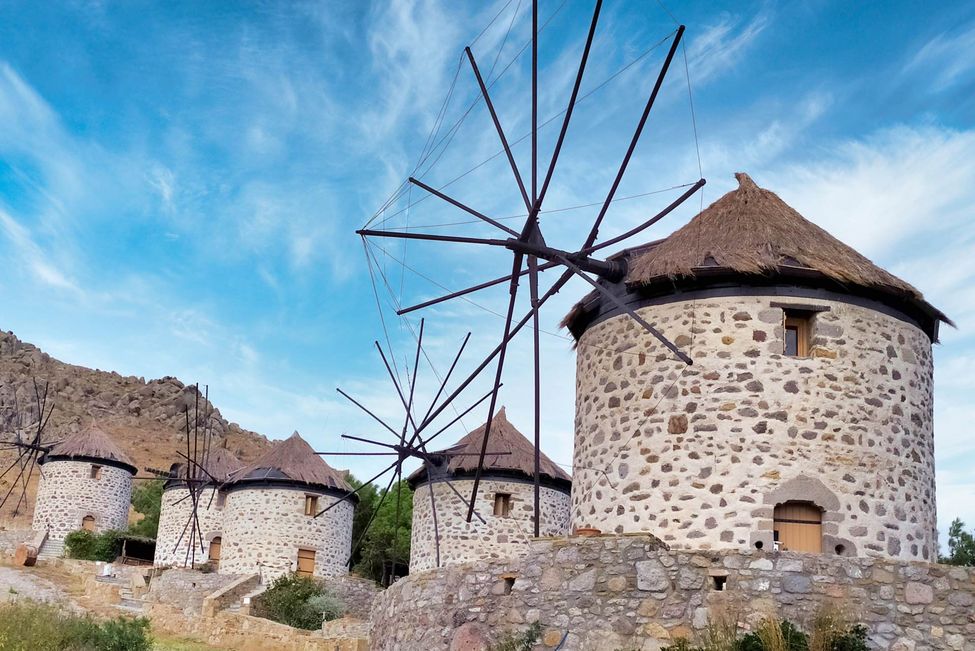
The village of Kontias on the south-western island of Limnos is well worth a visit. Its well-preserved architecture bears witness to the Byzantine and Ottoman eras. Today, it’s a charming hamlet of picturesque stone houses. Climb up the hill to see the old windmills, which have been renovated to give you a beautiful view of the island.
Stroll along the cobbled streets and further down to the small port of Agios Ioannis de Kontias: you can see the remains ofan ancient castle dating back to Venetian times.
10. Birdwatching around the three marine lakes
The island of Lemnos is home to three large saltwater lakes:
- Lake Alyki;
- Lake Asprolimni;
- Lake Chortarolimni.
Located near Kontopouli, these three lakes are part of the European Natura 2000 network. They are home to many bird species, including the black-winged stilt, the ring-necked pratincole and the lesser kestrel, as well asa large number of migratory birds. If you’re lucky, you may even spot pink flamingos from the observation towers. If you’re interested in ornithology, don’t miss this exceptional show!
The three marine lakes are also home to a rich ecosystem featuring specific plant species such as glasswort, sea daffodil, reed and the uniquely Greek presence of hemp in the sand dunes. This ecosystem varies with the seasons. In winter, Lake Aliki is a large expanse of salt water, while in summer the water evaporates, turning it into a salt marsh.
11. Discover the archaeological site of Poliochni
The eastern part of the island of Limnos offers a unique opportunity to visit the cradle of the first peoples of the Aegean: the archaeological site of Poliochni. The ancient town of Poliochni is considered to be the oldest in Europe, with 4 colonies built one on top of the other (blue, green, red and yellow). Blue Poliochni, the oldest, is thought to have been inhabited since the Chalcolithic era (4000 BC), long before the city of Troy, located opposite. And in the Bronze Age, Poliochni became one of the first known cities in Europe.
You’ll be able to admire the remains of an organized town with houses built side by side, streets, wells, squares where the inhabitants gathered and even the world’s first “Parliament”.
In Greek mythology, Lemnos is said to be the island of the Amazons, where Jason and the Argonauts stopped off on their way to Colchis on their quest for the Golden Fleece. In fact, rock engravings depicting an Amazon woman holding a bow have been discovered at Poliochni.
Take the opportunity to visit the archaeological museum. The tour will help you understand the different historical and architectural periods presented on the site.
Practical info: open Wednesday to Monday, 8:30 a.m. to 3:30 p.m. (closed Tuesdays). Full price €3. Due to renovation work, please consult the official website for more information.
12. Lemnos wine
In fact, this wine has been prized since Antiquity. The philosopher Aristotle referred to it as “Λημνία άμπελος” (“vine of the island Lemnos”), making the Lemnos vine the oldest attested in Greece. If you get the chance to taste it, you’ll have an idea of what the heroes of ancient Greece drank!
The island’s oldest grape variety is known as “limnio” or “kalampaki.” Limnio is used as a variety for the production of dry red wines, giving them a dark ruby color and subtle aromas of red berries. After fermentation in oak barrels, these wines develop their own depth, pairing perfectly with stews, savory dishes and flavored game dishes, among others.
In addition, Muscat of Alexandria is the predominant grape variety in the vineyards of Lemnos, making it one of Greece’s leading regions for the production of sweet wines.
Good health!
13. Taste the culinary specialties of Lemnos
Like many Greek islands, Lemnos cuisine favors local products:
- cheeses: kaskavali, melichloro or melipasto, kalathaki made from goat’s and sheep’s milk
- honey, especially thyme honey
- cereals, in particular for making Flomaria, handmade pasta
- legumes grown on the island’s plains: fava and beans
- Lemnos wine, known for its unique aroma due to its cultivation on volcanic soil. Try kalambaki or limnio (red) and muscat d’Alexandrie (white).
- almonds and figs, important ingredients in Lemnos cuisine
14. How do I get to the island of Limnos?
By plane
Lemnos is one of the Greek islands with its own airport (LXS). However, there are no direct flights from international. So you’ll have to fly via Athens or Thessaloniki, which will take you less than 1 hour. In summer, Limnos airport also connects with other Greek islands in the Northern Aegean, such as Lesbos (40 mins flight), Chios (1h45 flight), Ikaria (55 mins) and Samos (2h50).
To take a look at the different flights available, we use the user friendly website of Aegean.
By ferry
You can also reach the port of Myrina by boat. Maritime connections exist with :
- Attica and the ports of Athens, Piraeus and Lavrio (faster connections),
- Northern Greece: Thessaloniki, Kavala or Alexandroùpoli
- North Aegean islands: Samothrace, Agios Efstratios, Lesbos, Chios, Samos and Ikaria
- the Cyclades islands of Syros, Tinos and Mykonos
- the Dodecanese islands of Patmos and Leros
To see the different timetables, journey times and fares, we always use Ferry Hopper. Tickets can be conveniently booked online at competitive rates!
15. And getting around Lemnos?
Lemnos has a well-developed bus network linking the port of Myrina to various villages and beaches in summer.
But for even more freedom, we recommend renting a car, which you’ll find at the airport or at the port of Myrina.
Beware: Lemnos is an island where you’ll find dirt roads, especially to reach isolated beaches or certain archaeological sites. Drive slowly!
16. Where to stay in Lemnos?
Lemnos offers a wide range of accommodation: hotels, apartments, studios, houses… In particular, you will find a wide range of products and services on Booking.
Now you have a good guide to prepare your stay and visit Lemnos: must-sees and must-dos, how to get to Limnos? and where to sleep on the island.
We hope you enjoy discovering the island of Limnos!
Sandra B.

